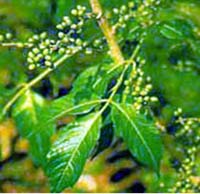Melada Pahit
| Melada Pahit | |
| Scientific Name | Brucea amarissima (lour.) Desv. Ex B.A. Gomes (Simaroubaceae) |
| Family | Simaroubaceae |
| Synonyms | Rhu chinensis, Brucea javanica (L) Merr, B. sumatrana |
| Common Name | lada pahit, chinese gall brucea, chinese sumac , gallnut, ya tan tze (Chinese) |
 |
{slider=Geographical & Distribution}
Southeast Asia to Northern Australia
{/slider}
{slider=General Appearances}
Evergreen shrub. The Flower: polygampus, 0.5 cm, long, axillary panicles. The floral parts arise in acropetal succession in the perfectly tetramerous flower. Occur in axillary panicles. The floral parts arise in acropetal succession in the perfectly tetramerous flower. The pedicel and outer surface of the sepals show unicellular, multicellular, and glandular bairs.
{/slider}
{slider=Chemical Contituents}
Seed: Quassinoid glucosides, javanicosides I. J., K. and L. Bruceins D and E. Yadanziosides B,C, E, I and K, bruceoside B and yadanzigan (Kim IH, Hitosuyanagi Y., Takeya K. (2004). Indole alkaloid canthin-6-one
{/slider}
{slider=Traditional Uses}
To treat diaria, bloody stool,worms mel, high blood pressure, cholera and gastric: Boil the dried fruit, seed in water and drink, to treat malaria, corroding verruca. Indonesia: the fruit used as anti malaria, anti-pyretic, and homostatic effects. In China the fruits to treat malaria, amoebic dysentery, insecticide and anti cancer
{/slider}
{slider=Pharmacology}
Antioxidant
B.amarissima bark appears to be the most promising source of cytotoxic and antioxidant compounds. B. amarissima gave the lowest LC50 and EC50 values for brine shrimp lethality assay (BSLA) and DPPH radical scavenging activity, respectively. B. amarissima (crude ethanol, methanol and chloroform soluble) extracts were shown to be active against HeLa cells (Nonita P.P. & Mylene M.Uy 2010)
Fungistatic
Crude extract of B. amarissima leaves crude extract exhibited fungistatic (<6mg/mL) and fungicidal (>6mg/mL) activities towards oral Candida sp. (Harun W.W. et al 2011).
{/slider}
{slider=Toxicity}
Brucea javanica leaves extract was administered orally for the first 24 hours at various dose levels (562.5 mg/kg bw (body weight), 1125 mg/kg bw, 2250 mg/kg bw, and 4500 mg/kg bw) to determine the toxicity effects on DDL mice. Vital organs average weight showed no difference between the control group and the treatment groups from the lowest dose until the highest dose. In addition, the body weight data showed no difference between the control group and the treatment groups. LD50 for Brucea javanica extract using Reed and Munich formula was 1003.65 mg/kg bw. The result of the study showed that the extract was categorized as “slightly toxic” (Marissa Angelina et al 2012).
{/slider}
{slider=Reference}
Harun W.W. , M. Nordin, F. Abdul Razak (2011). Inhibitory Effect of Crude Aqueous Brucia amarissima Extract on the Growth Profile of Oral Candida. https://www.thieme-connect.com/ejournals/abstract/ 10.1055/s-0031-1282471.
Marissa Angelina, Indah D. Dewijanti, Banjarnahor SDS, Megawati, Tri Yulian. (2012). Acute Toxicity of Brucea javanica Merril Leaves Extract on Mice. The Journal of Tropical Life Science. Vol 2 (3) Pg 29-31.
NC Nair & N.P. Sukumaran (1960). Floral morphology and Embroology of Brucea Amerissima http://www.jstor.org/discover/10.2307/2473375?uid=364287361&uid=3738672&uid=2129&uid=2&uid=70&uid=3&uid=67&uid=5910200&uid=62&uid=40488&sid=21103057983703
Nonita P. Peteros & Mylene M. Uy (2010). Antioxidant and cytotoxic activities and phytochemical screening of four Philippine medicinal plants. Journal of Medicinal Plants Research Vol 45 (5) Pg 407-414.
Kim IH, Hitosuyanagi Y., Takeya K. (2004). Phytochemistry 65 (23) Pg 3167-73.
{/slider}
- Last updated on .
- Hits: 4809
